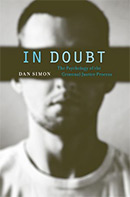In Doubt: The Psychology of the Criminal Justice Process

Author: Dan Simon
Cambridge, MA: Harvard University Press, 2012. 405p.
Reviewer: George C. Thomas III | September 2012
Professor Dan Simon’s book is a smart and detailed demonstration of how the criminal system fails to achieve sufficient accuracy in sorting the innocent from the guilty. In my 2008 book, I argued that the Due Process Clause requires procedures that advance accuracy at a reasonable cost. (Thomas, 45-55).Simon offers the best explanation yet of how the system fails and, more importantly, why it fails. His training as a psychologist as well as a lawyer is immensely helpful in analyzing a mountain of empirical evidence. He develops what I would describe as a “unified theory of false convictions”—convictions of the innocent are largely caused by the human need to achieve coherence when faced with incomplete stories and by the system’s opacity. All participants in the system, from victim to police officer to prosecutor to judge and jury to the appellate courts, strive to create a coherent story out of the bits and pieces of raw data that are assembled. And the data themselves are inherently flawed because the gathering process is opaque. Evidence is often the human recollection of what someone did or said months or years ago. But human memory is an active process that unavoidably distorts as it recalls, and memory decays over time.
As Simon notes, the accuracy problem begins with the investigative process. The power of this observation cannot be overstated. If the police arrest the wrong suspect but manage to build a (usually) circumstantial case against him, the adjudicatory process is ill-suited to flush the case out of the system. The biggest problem is that police necessarily use a process that Simon calls “abductive reasoning.” Just as Kant observed that causation might simply be the result of the human mind imposing order on chaos, abductive reasoning is the process by which one imposes order on the “infinite amount of evidence that might have any bearing on the case.” (Simon, 21) An investigator must have a hypothesis before deciding which evidence is relevant. “Hence the circular nature of investigative reasoning: evidence is necessary to test hypotheses, while hypotheses are necessary to decide which evidence to pursue.” (Simon, 22) It is no accident that Western culture has made a hero, if not a fetish, of Sherlock Holmes for his generation of creative hypotheses.
Once police have settled on a hypothesis, several factors create a powerful “tunnel vision” that too often excludes competing hypotheses. These factors include confirmation bias, emotional identification with the victim, and group biases. Hovering over the police investigation like a noxious cloud is what Simon calls the problem of conflicting roles. The role of solving crimes is sometimes in tension with the role of building a case for the prosecutor. An officer committed only to solving the crime might be more willing to admit that the evidence doesn’t add up to a plausible case than the officer who feels an “adversarial pull” toward creating a prosecutable case.
Sherlock Holmes is a fictional character who solved one case at a time. Real police have personal lives, tall stacks of case files, and pressure from superiors, from politicians, from victims, and from fellow officers. Given the inherent flaws of human beings and of the situation in which police find themselves, it is probably a testament to their dedication to the job that they don’t make more errors than they (apparently) do.
So police make mistakes? So what? The conventional story of American justice, one that most of us believed until hundreds of cases of false convictions were documented, is that the various screening mechanisms of our vaunted adversarial system flush out (almost) all of the innocent defendants. Most states provide preliminary hearings and grand jury proceedings, both of which are available to screen out innocents. How many innocent defendants are in fact screened out by these early mechanisms is unknown. Once one examines how these mechanisms work, however, any notion that they provide an effective screen is revealed as a triumph of hope over reality. Both require only probable cause to believe the defendant guilty, a very low standard. In both settings, the State is not required to “show its hand”—it does not have to present any exculpatory evidence or witnesses who might reveal weaknesses in the State’s case. The grand jury is even less effective as a screen than the preliminary hearing. No judge is present in the grand jury room, and the defendant and his lawyer are not permitted to be there; the prosecutor is in control of the proceedings and can show probable cause solely with evidence that will not even be admissible at trial, e.g., hearsay evidence. Sol Wachler, at the time a respected chief judge of New York’s highest court, famously remarked that a competent prosecutor could get a grand jury to indict a ham sandwich.
If we accept that pre-trial mechanisms, as currently constructed, are not effective screens, what is left to protect innocent defendants? The prosecutor could serve as a screen if she challenged the case the police hand over to her. (See Medwed.) This screening role should in theory be enhanced by the constitutional requirement (Brady v. Maryland, 1963) that prosecutors turn over exculpatory evidence in the possession of the State. But this theoretical advantage offered to innocent defendants is in practice evanescent. Cases in which the State is aware of substantial exculpatory evidence rarely make it to the prosecutor. Cases that stay in the system feature defendants who look guilty. The job of the prosecutor is to obtain a guilty verdict, almost always by plea bargain.
Moreover, prosecutors face the same pressures as police to clear cases and get convictions. Without some institutional mechanism to review cases, the tunnel vision that caused the police to close the case will infect the decision to prosecute. One attempt at an institutional mechanism within the prosecutor’s office is the Conviction Integrity Program created by Manhattan District Attorney Cyrus Vance, Jr. in 2010. Part of the program is a Conviction Integrity Committee that is comprised of ten senior members of the District Attorney’s staff. Their job is to review practices and policies related to training, case assessment, investigation, and disclosure obligations, with a focus on potential errors such as eyewitness misidentifications and false confessions. It is too soon to know how effective this program will be.
Twenty years ago, the false conviction skeptic would have sneered at the theoretical failures of the investigation and pre-trial screening processes. The skeptic would assure us that innocent defendants do not plea bargain. They go to trial and avail themselves of the great Anglo-American invention that permits the truth to come out. Matthew Hale acclaimed the English common law jury trial as the “best Trial in the World,” in large part because having witnesses testify in person—subject to being questioned by the parties—was the “best Method of searching and sifting out the Truth.” (Hale, 252.) Hale might have been right that the English system was the most accurate one in the world in 1713, but the implication that the adversary adjudicatory system is good at “sifting out the Truth” is simply wrong.
Simon lays out the reasons why the adjudicatory system is so bad at “sifting out the Truth” in two brilliant chapters. In sum, juries suffer many of the same problems that plague the police. The fact-finder needs to create a coherent story that makes sense. Once that story is in the mind of the jury, it minimizes contrary evidence and accentuates the confirming evidence. That juries are seeking to make a coherent story out of the State’s evidence suggests that the much-vaunted standard of proof beyond a reasonable doubt does not make much difference. (See Givelber.) Either the jury believes the story that it constructs out of the evidence it hears or it does not. If it believes the story, by definition there is no reasonable doubt. The presumption of innocence is similarly flawed as a way to protect innocent defendants.
Simon’s chapters on the profound failures of jury fact-finding are devastating. I represented one criminal client I thought innocent. The prosecutor in the misdemeanor child abuse case appealed to the jury’s emotions and got a guilty verdict in the face of substantial evidence of innocence. I have always regretted not attempting to waive the jury and try the case to the judge. After reading Simon’s chapters 6 and 7, I wonder if I would ever put an innocent criminal client’s fate in the hands of a jury.
There is no disputing Simon’s ultimate claim that a criminal justice system must achieve a certain level of accuracy to maintain its legitimacy. Otherwise, the risk of wrecking the lives of innocent people “casts a disconcerting shadow over the integrity of the system.” (Simon, 215). Part of the remedy he proposes is a change in the mind-set of the relevant actors. Rather than simply assuming, or hoping, that the system achieves sufficient accuracy to maintain legitimacy, those “who design, oversee, and operate the criminal justice process ought to place a higher priority on reaching accurate verdicts.” Perhaps more importantly, they should “acknowledge that, in its current form, the process cannot be expected to meet its objectives.”
As for specific recommendations, Simon offers two sets. One is directed at improving the facts given to the jury. (Simon, 178-79). It includes standard recommendations to limit eyewitness identification evidence as well as new ideas on jury instructions. Simon follows Richard Leo’s sound recommendation to admit confessions only if there is a high degree of proof that they are reliable as well as voluntary. (See Richard A. Leo, 2009, 283-291). The second set of recommendations is directed toward helping the system reach accurate outcomes with the facts that it has. (Simon, 204-05). So, for example, potential jurors should be screened more thoroughly for potential bias, jury instructions should be written in plain language, and appellate courts should be more willing to take a fresh look at convictions when defendants make a “substantial showing of innocence.” (Simon, 205). The latter suggestion was prominent in my recommendations in 2008. (Thomas, 214-222).
Simon’s most powerful reform is to create transparency in police investigation. If the defense has a thorough record of the police investigation, the flaws in the State’s case would be easier to spot. Simon proposes making an electronic record of all investigative procedures. (Simon, 217). This would help the State as well as the defense by making available an accurate record of what was said and done during the investigation. The memories of witnesses, however imperfect, are better captured at the earliest possible time rather than waiting for trial. The help to both sides would be in the direction of accuracy, the goal to which the system should strive. If more likely innocent defendants are screened out of the process at the same time as more likely guilty defendants become easier to convict, everyone benefits. (See Medwed, Pizzi)
As my book points out, making a record of the police investigation is at the heart of the Continental inquisitorial system, in which an impartial magistrate oversees the collection and preservation of evidence. How well that system works in practice is unclear. But the value of Simon’s reform proposal is the simultaneous electronic recording of the investigation, which would be a vast improvement over even the best magistrate system where police fill out reports and file them with the court.
Simon’s unified theory of false convictions teaches us that we must face the twin problems of coherence and opacity. Both problems can be minimized by having an accurate picture of the evidence as it is being gathered.
George C. Thomas, III is the Rutgers Board of Governors Professor of Law & Judge Alexander P. Waugh, Sr. Distinguished Scholar at Rutgers School of Law – Newark.
Biblliography
Brady v. Maryland, 373 U.S. 83 (1963).
Matthew Hale, The History and Analysis of the Common Law of England (1713).
Richard A. Leo, Police Interrogation and American Justice (2009).
Daniel Medwed, Prosecution Complex: America’s Race to Convict and Its Impact on the Innocent (2012).
William T. Pizzi, Trials Without Truth: Why Our Criminal Justice System Has Become an Expensive Failure and What We Need to Do to Rebuild It (1998).
George C. Thomas III, The Supreme Court on Trial: How the American Justice System Sacrifices Innocent Defendants (2008).
Daniel Givelber, Meaningless Acquittals, Meaningful Convictions: Do We Reliably Acquit the Innocent?, 49 Rutgers L. Rev. 1317 (1997).
Richard A. Leo, Steven Drizin, Peter Neufeld, Brad Hall, and Amy Vatner (2006), Bringing Reliability Back In: False Confessions and Legal Safeguards in the Twenty-First Century, 2006 Wis. L. Rev. 479.
D. Michael Risinger, Innocents Convicted: An Empirically Justified Factual Wrongful Conviction Rate, 97 J. Crim. L. & Criminology 761 (2007).
D. Michael Risinger, Unsafe Verdicts: The Need for Reformed Standards for the Trial and Review of Factual Innocence Claims, 41 Hous. L. Rev. 1281 (2004).
Tom Stacy, The Search for Truth in Constitutional Criminal Procedure, 91 Colum. L. Rev. 1369 (1991).
Sandra Guerra Thompson, Beyond a Reasonable Doubt? Reconsidering Uncorroborated Eyewitness Identification Testimony, 41 U.C. Davis L. Rev. 1487 (2008).


